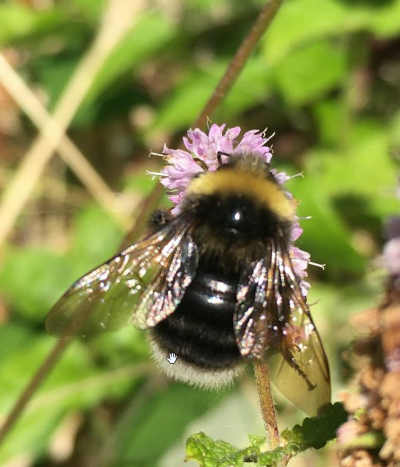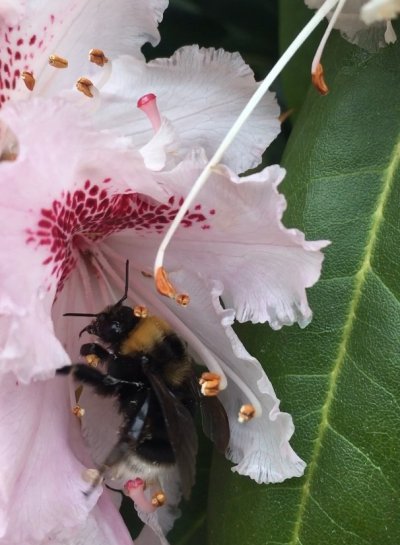WWU student rediscovers regionally extinct bumblebee on Western’s campus
The western bumblebee, an endangered native bee species thought to be locally extinct, has been rediscovered on Western’s campus by Environmental Science student (now alumna) Audrey Mechtenberg.
Known taxonomically as bombus occidentalis, the western bumblebee once flourished across the West Coast and its range stretched as far east as Montana. Between 1998 and 2018, population numbers of the western bumblebee dropped 93 percent in this region— only occasional pockets of sightings have remained. Specific numbers for lowland Whatcom County are unavailable due to the lack of systematic pollinator surveys conducted in this area.
While spotting a western bumblebee was believed to be unlikely at best, Mechtenberg set out on an independent senior project in the hopes of spotting one.
Mechtenberg’s project took place over seven months, concluding her research in September 2020 in time for her to graduate last fall.
“I was super thrilled when I started this research project, way back over a year ago,” Mechtenberg said. “When I was speaking with some professors on campus they told me, ‘we haven't seen a western bumblebee here for years and years and years.’ I was kind of disappointed, so I didn't really get my expectations up.”
Then, two months into her research, a western bumblebee drifted its way across Mechtenberg’s path among WWU’s blooming rhododendrons.
“I feel like I kind of have an intuition when it comes to these sightings,” Mechtenberg said. “You have to have a really quick eye to know what you're looking for, and I just knew as I was staring at this rhododendron that something was there. Sure enough, a western bumblebee just flew right in front of me.
“I was so excited I could barely get my camera out to take pictures of it. I stayed there for a long time, I probably took 100 pictures of this bumblebee. It was really exciting.”
Anu Singh-Cundy, associate professor of Biology at Western and research supervisor to Mechtenberg’s work, said that while nothing is promised about the return of this species, this recent development is reason for hope.
“Audrey's sightings, and also some from King County and elsewhere on the coast, show that the species is struggling to make a comeback, but the odds are stacked against it,” Singh-Cundy said. “Audrey's work is actionable. It suggests ways that gardeners, nature lovers and land managers can help native bumblebees."
A local oasis
Over the next four months, Mechtenberg recorded five more sightings of the western bumblebee on campus. Six total sightings in one season, while certainly a slim number, offers a glimmer of hope for this species.
“For not really seeing any western bumblebees in this area to having six recorded sightings in one area in Bellingham is really, really exciting,” said Mechtenberg.
Western’s campus provides a huge and varying habitat for bees in this region. The Arboretum, the Outback farm, various gardens and Western’s extensive landscaping all create an oasis for bees against the urban environment of the greater Bellingham area.
According to Heidi Zeretzke, Western’s head gardener, Western intentionally integrates sustainability and ecological impact into their landscaping practices. By incorporating native plant species into landscaping and leaving natural leaf and tree limb debris, local plant and animal species are encouraged to flourish.
Western also limits their use of pesticides to almost zero, only using them on noxious and invasive plant species when all other options have been exhausted. Limiting the use of chemical pesticides prevents bees from bringing the harmful chemicals back to their hives.
“The downside of not using the chemical approach is that sometimes people have to adjust their expectations about how things should look,” Zeretzke said. “For instance, we don’t use broad leaf chemicals on lawn areas anymore, so there are more dandelions and other weeds in lawn areas that people have to get used to seeing.”
With the confirmation of the existence of western bumblebee populations, even small populations, there’s no time like the present to get involved in helping this species. The easiest way anyone can help is to keep a close eye out for western bumblebees, which can be identified by their fuzzy, mostly-black bodies with white rears; see the downloadable bumblebee identification guide at the bottom of the page for help.
The most common native bumblebee, bombus bifarius (or its common name, the two-form bumblebee), can be identified by their fuzzy bodies and the vague black T shape on their abdomen. Variants of the two-form bumblebee can have black and yellow stripes, or red and yellow stripes if they’re at a higher elevation. These species can be distinguished from the western bumblebee by the western bumblebee’s trademark white rump.
How you can help
If you’re lucky enough to spot a western bumblebee, snap a photo of it and submit it to bumblebeewatch.org. After creating an account and submitting your photo, an expert will verify your spotting.
These types of citizen submissions are invaluable resources for scientists and researchers; Robin Kodner, a professor of biology at Western, uses a similar tactic in her research examining different species of algae.
“Scientists can only be in one place at one time,” Kodner said. “Even if I was to go out in the field every single day for an entire growing season, I wouldn’t be able to cover the diversity across the Cascade mountains. So getting folks who are already going into the mountains to gather samples and make observations can help us map out the algae locations at any given time.”
Another way you can help native bumblebee populations (not just western bumblebees) is by planting native flower species, according to Mechtenberg. Planting native flowers prioritizes the needs of native bee species, western bumblebees included, but also lends a hand to other bee species like honeybees, that are crucial to our agricultural system.
Heather, a common flower in Bellingham, is loved by honeybees and blooms through the winter, providing much-needed sustenance for queen bees who also wake up at that time. Red flowering currant blooms in the early spring, when bees' winter food supply is at its lowest— collecting nectar at this time is crucial in sustaining colonies until mid to late spring. Other plants that aren’t native but have been naturalized are lavender and lemon balm, both of which bloom in mid to late summer.
Helping local bee species can be as easy as letting natural foliage grow. “One of the biggest takeaways should be to create more nest sites and overwintering sites by letting part of the garden go wild, with undisturbed brush piles and unmowed grass,” Singh-Cundy said. “Rock walls with plenty of gaps are great nest sites.”
According to Singh-Cundy and Mechtenberg’s research, the greatest local threat to the western bumblebee is the eastern bumblebee. Eastern bumblebees, native to the eastern coast of North America, are released on cranberry farms in British Columbia to help pollinate the crops — so while the release of these bumblebees on the American west coast is banned by the USDA, Canadian bees are crossing the border. Eastern bumblebees are especially strong in this area due to their resistance to the Nosema infection, a fungal parasite that leads to honeybee sickness and death.
Mechtenberg’s work serves as not only a jumping-off point for the recovery of this species, but also helped identify multiple local threats to native bee species.
“Audrey set out to find what we've got by way of bumblebee species, which are among the most efficient pollinators of native plants and also of crops like blueberries and raspberries, much better than the non-native honeybees," Singh-Cundy said. "Along the way, she re-discovered the western bumblebee and identified the threat from the eastern bumblebee.”
What's next?
Since graduating, Mechtenberg began working with the Washington Conservation Corps maintaining outdoor trails in Whatcom County. She doesn’t currently have any plans for more pollinator surveys, but Mechtenberg still makes sure to keep an eye out for bumblebees and flower species in her work.
“This is a really unique opportunity for people to learn about the western bumblebee, as it’s a potentially endangered species that lives in the same place we live,” Mechtenberg said. “There are a ton of community science programs that anyone can participate in. This not only helps people just get connected to nature, but also it's a way for people to get involved in conserving an endangered species.”
To learn more about how you can help bees in the Whatcom County area, visit the Whatcom County bee resources website here.
Want to learn more? Here are some citizen-science projects you can be a part of:
- The Cascades Butterfly Project: https://www.nps.gov/articles/cascades-butterfly-project.htm
- Robin Kodner's Living Snow Project: https://www.nps.gov/articles/cascades-butterfly-project.htm
- Bumblebee Watch: bumblebeewatch.org
- Project Feederwatch: https://feederwatch.org/
- Ebird: https://ebird.org/home

